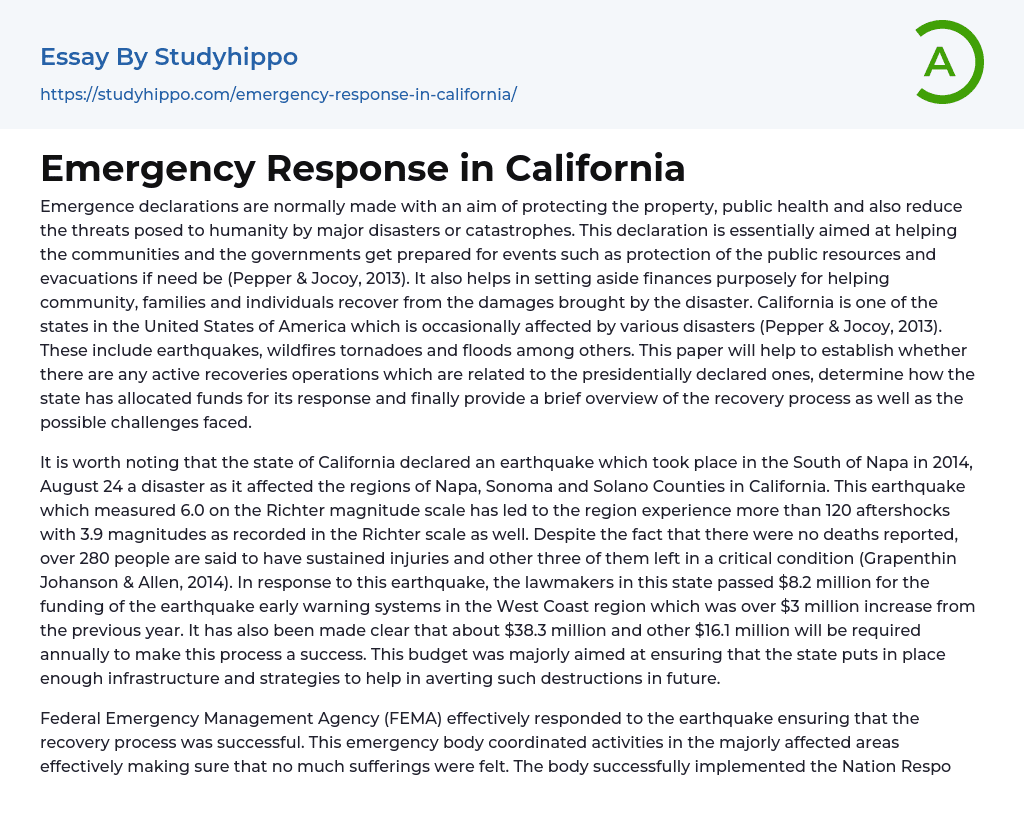Emergence declarations are normally made with an aim of protecting the property, public health and also reduce the threats posed to humanity by major disasters or catastrophes. This declaration is essentially aimed at helping the communities and the governments get prepared for events such as protection of the public resources and evacuations if need be (Pepper & Jocoy, 2013). It also helps in setting aside finances purposely for helping community, families and individuals recover from the damages brought by the disaster. California is one of the states in the United States of America which is occasionally affected by various disasters (Pepper & Jocoy, 2013). These include earthquakes, wildfires tornadoes and floods among others. This paper will help to establish whether there are any active recoveries operations which are related to the presid
...entially declared ones, determine how the state has allocated funds for its response and finally provide a brief overview of the recovery process as well as the possible challenges faced.
It is worth noting that the state of California declared an earthquake which took place in the South of Napa in 2014, August 24 a disaster as it affected the regions of Napa, Sonoma and Solano Counties in California. This earthquake which measured 6.0 on the Richter magnitude scale has led to the region experience more than 120 aftershocks with 3.9 magnitudes as recorded in the Richter scale as well. Despite the fact that there were no deaths reported, over 280 people are said to have sustained injuries and other three of them left in a critical condition (Grapenthin Johanson & Allen, 2014). In response to this earthquake, the lawmakers in this state passed $8.
million for the funding of the earthquake early warning systems in the West Coast region which was over $3 million increase from the previous year. It has also been made clear that about $38.3 million and other $16.1 million will be required annually to make this process a success. This budget was majorly aimed at ensuring that the state puts in place enough infrastructure and strategies to help in averting such destructions in future.
Federal Emergency Management Agency (FEMA) effectively responded to the earthquake ensuring that the recovery process was successful. This emergency body coordinated activities in the majorly affected areas effectively making sure that no much sufferings were felt. The body successfully implemented the Nation Response Plan ensuring that they overcome and substantially mitigated any operational challenges. Lastly they effectively partnered with the locals thus ensuring a coordinated resource utilization thus saving on the operation costs in several regions of the affected area. In February, 2015 FEMA allocated $3.4 million mainly for public assistance program and over $10.9 million set for individual assistance. However this body was faced with various challenges during its response to the earthquake since most of the region’s infrastructure had been damaged making accessibility a major challenge. Power lines, water mains and also gas lines and also the Napa Airport. All these pitfalls made it expensive to have the emergence responded at immediately. The fact that this earthquake was followed by severe fires brought about drought all over the state destabilizing the state’s resources. As a result of this California is now facing five consecutive droughts leading to the government authorizing $678 million to relief the citizens from the disaster (Grapenthin
Johanson & Allen, 2014).
In conclusion therefore it is necessary for the state to fully collaborate and enhancing its working with the FEMA so as to ensure that the necessary information pertaining disasters are responded to at the right time. Since the U.S. Geological Survey has financed four institutions to conduct research which will help in supporting the transition of the shakes and provision of early warning, this information needs to be disseminated to all the people in the state (Manoj &Baker, 2007). This can be done through civic education.
References
- Grapenthin, R., Johanson, I., & Allen, R. M. (2014). The 2014 Mw 6.0 Napa earthquake, California: Observations from real?time GPS?enhanced earthquake early warning. Geophysical Research Letters, 41(23), 8269-8276.
- Manoj, B. S., & Baker, A. H. (2007). Communication challenges in emergency response. Communications of the ACM, 50(3), 51-53.
- Pepper, D. A., & Jocoy, C. L. (2013). A climatological analysis of emergency homeless shelter openings in Long Beach, California, USA. Applied Geography, 37, 168-175.
- Field essays
- Afghanistan essays
- Africa essays
- America essays
- Asia essays
- Australia essays
- Caribbean essays
- City essays
- Developing Country essays
- Dubai essays
- Earthquake essays
- Europe essays
- Fracking essays
- Georgia essays
- Middle East essays
- Natural Disaster essays
- New Zealand essays
- North Korea essays
- South Korea essays
- Thailand essays
- Travel essays
- Aviation essays
- Emergency Management essays
- Health Insurance essays
- Insurance essays
- Life Insurance essays
- Public Transport essays
- Transportation essays
- Air Pollution essays
- Carbon Dioxide essays
- Climate essays
- Deforestation essays
- Ecology essays
- Endangered Species essays
- Environmental Issues essays
- Environmental Protection essays
- flood essays
- Greenhouse Gas essays
- Hurricane essays
- Nature essays
- Pollution essays
- Renewable Energy essays
- Sustainability essays
- Tornado essays
- Traffic essays
- Tsunami essays
- Water Pollution essays




